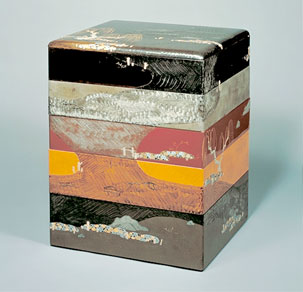|
|
|
Colours

|
an unusually colourful 17th Century box, for storing the texts of Noh plays
|
The lacquer is almost clear (with a hint of brown), and was traditionally
only tinted to black (from iron) or red (from mercury sulphide or iron oxide).
Other colours came from sprinkling of metal dust/flakes, but some bright
colours were unknown in lacquerware until the 20th Century. This technique
is called maki-e: careful sprinkling of gold or silver (or other coloured
dusts) onto the wet lacquer. Other decorative materials included
mother-of-pearl, ceramics, abalone, pewter. I won't go into great detail on
this, as there are whole books on the subject: to give a flavour, sizes of
metal dust-to-flakes come in 31 standard grades.
backwards: cores
|
|

